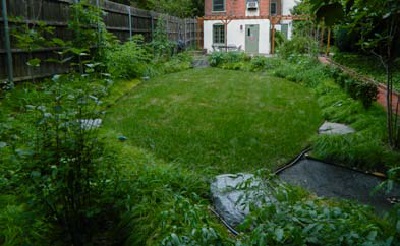

Pictured above is the Lenape Garden, located at 37th and Chestnut behind the University of Pennsylvania's Greenfield Intercultural Center, which is home to the student group Natives at Penn. The garden, which was completed in 2013, was designed in collaboration with the local Lenape community and Penn landscape architects. It features plants native to Pennsylvania and a turtle-shaped design, honoring the Lenape creation story, in which the Lenape people were carried to their homeland on the back of a turtle.
Native Americans are the original inhabitants of the land now known as the United States. The ancestors of Native Americans (as well as the Indigenous people of Canada, Mexico, and Central and South America) came to this land at least 15,000 years ago from Asia, crossing the Bering land bridge, a mass of land that once connected North Asia to what is now Alaska.
After the arrival of settlers from Europe, the population of Native Americans declined severely because of diseases introduced from Europe, warfare, slavery, and ethnic cleansing. Many Native Americans were displaced from their homelands and forced to move further west to make room for white settlements. Later, the U.S. government adopted a policy of forced assimilation, so that many Native children were taken from their families and educated in "residential schools," where they often faced abuse and cultural repression.
Today, the U.S. government recognizes tribal sovereignty on designated lands known as reservations. On reservations, tribes have the ability to pass laws and create treaties with little interference from state or federal governments. However, 78% of Native Americans today live outside of reservations, with many residing in large western cities such as Los Angeles, Phoenix, or Oakland.
Activism by Native people has resulted in many victories for civil rights and self-determination, but Native Americans statistically continue to face serious issues regarding quality of life, including higher rates of poverty, violent crime, and public health challenges like diabetes and substance abuse disorders. These issues are a result of the historical oppression of Native people and ongoing trauma.
In the past, Native people in the United States and elsewhere in the Americas were commonly called "Indians." This is because, when Christopher Columbus first reached the Caribbean, he mistakenly thought that he was in the Indian Ocean and therefore referred to the native Caribbean peoples as Indians, and the name stuck. Although some Native people may still refer to themselves as Indian today, the term Indian by itself is generally considered derogatory and disrespectful when used by non-Native people. More accepted terms include Native American, American Indian, or Native/Indigenous people. Some Native people individually prefer one term over another. First Nations and First Peoples are terms commonly used in Canada. In general, people may prefer to be referred to with their specific tribe or nation's name where possible.
The land where Manor College stands is located in Lenapehoking, the traditional homeland of the Lenape people. In addition to the easternmost part of present-day Pennsylvania, Lenapehoking includes all of present day New Jersey, as well as parts of present-day New York and Delaware.
By the end of the 18th century, most Lenape had been pushed out of Lenapehoking by white settlers and were displaced to what is now Ohio. Throughout the 19th century, the Lenape were pushed farther and farther west. Today, some Lenape still live in the Lenapehoking region, but there are larger communities in Oklahoma, Wisconsin, and Ontario.
In the video below, ABC interviews two descendants of the Lenape who have returned to New York City to participate in a pow wow.
Outside of the United States, there is a larger global conversation surrounding the rights of indigenous peoples. Generally speaking, an indigenous people is defined as a group that originally inhabited an area, in contrast to another group that settled there more recently. Examples of indigenous peoples around the world, apart from Native Americans, include:
Aboriginal and Torres Strait Islander peoples of Australia
Māori people of Aotearoa/New Zealand
Pacific Islanders, indigenous peoples of Melanesia, Micronesia, and Polynesia (including Hawai'i)
The Ainu in Japan
Indigenous people of the Philippines (close to 100 different groups)
Sami people of Scandinavia
The Nahua, Maya, Zapotec, Mixtec, and many other groups in Mexico and Central America
These communities represent a diversity of cultures and languages, and every indigenous group, tribe, or nation is unique. However, indigenous peoples are often marginalized compared to the more recently arrived settler populations, so there are a number of issues that they commonly face. These include displacement, threats of ethnic cleansing, land rights issues, poverty, health disparities, repression of language and culture, language loss, and more. The United Nations has taken steps to promote justice for indigenous peoples around the world, including passing General Assembly resolutions on the rights of indigenous peoples and appointing a Special Rapporteur who is responsible for reporting on the situation of indigenous peoples in various countries and addressing allegations of human rights violations. For more about these initiatives, you can explore this page.
